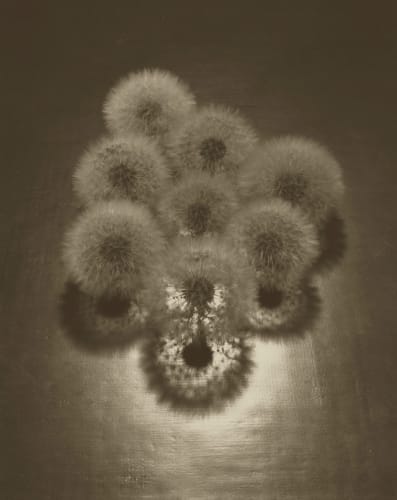NEW YORK, NY — Ippodo Gallery proudly presents contemporary names in Japanese photography at the 43rd edition of the Photography Show, hosted by AIPAD from April 25–28, 2024 in New York, USA. The gallery’s debut presentation draws together the ephemeral moments in the natural scenery narrated through the lenses of three living Japanese artists: Ryuji Taira, Takashi Tomo-oka, and Kenji Wakasugi.
The roots of many traditional Japanese art forms derive from the ever-changing seasons, highly variable landscapes, and the elements of nature. Between them exists a shared aim: to capture the ephemerality and transience of existence. This deep-seated respect for the environment—termed "kacho-fugetsu,” the appreciation of flowers, birds, wind, and the moon—is a fundamental aspect of the Japanese psyche that holds a profound influence over the realm of Japanese photography.
Using a large-format camera and silver halide film, Ryuji Taira (b. 1960) transforms dandelions into timeless, immortal microcosmos on washi paper. Taira’s prints, for the most part, hint at the mere details of a background setting. Dandelions are presented with an absolute focus. Enveloped in a rich shroud of shadows, Taira honors the dandelion as a symbol of the chronicles of life—bathed in the spotlight, the fluffy pappus unfurls.
Takashi Tomo-oka (b. 1971) creates painterly prints in homage to the traditional Rimpa style from the 17th century while ushering in a new era of technique and sensibility. Embracing “super flat” aesthetics by printing a digital image on washi paper, Tomo-oka deliberately avoids perspective and any background shading to capture a two-dimensional essence. Swaying on the shadowless paper surface, pine, plum, and maple—among Tomo-oka’s many motifs—yield an appreciation for the unadulterated beauty of these natural subjects.
Kenji Wakasugi (b. 1941) meticulously weaves a sense of reverence for shadows and negative space into his platinum prints, inspired by Jun’ichirō Tanizaki's essay, "In Praise of Shadows." Dripping in dim light, Wakasugi fusuma (traditional sliding door) series effortlessly blends fleeting nature scenes captured on analog film. Simultaneously, the ambiance of a classical Japanese interior was shot with a digital format lens. The synthesis of these two formats melds into one silent picture—the sliding doors suggest the edge of two realms; interior and exterior, light and shadow, black and white. His work holds a prominent place in major museums such as the Philadelphia Museum of Art, and has been showcased in exhibitions across Japan, the United States, and Belgium.



